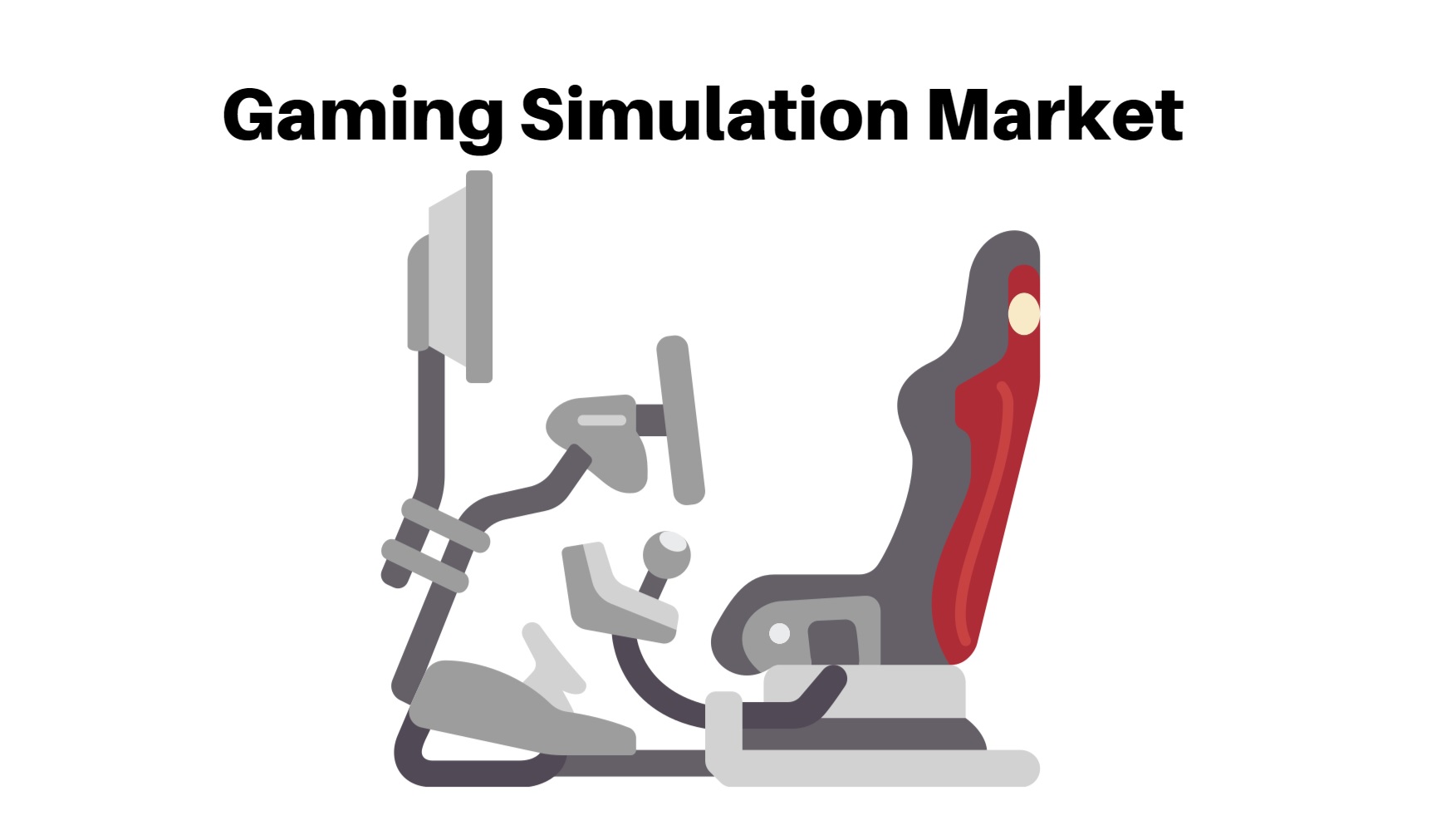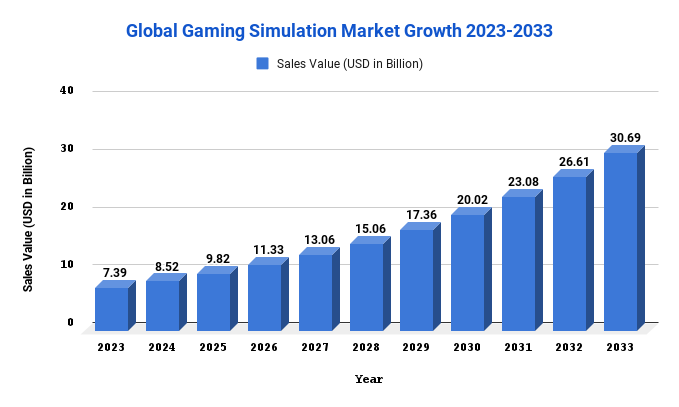Gaming Simulation Market will reach USD 30.69 Bn by 2033 At CAGR 15.3%

Page Contents
Market Overview
Published Via 11Press: The gaming simulation market has experienced remarkable growth over the last few years, driven by advances in technology, an increasing desire for immersive gaming experiences, and overall growth within the industry. Gaming simulation refers to using advanced techniques like virtual reality (VR), augmented reality (AR), and 3D graphics in order to create highly realistic environments where players can interact with digital objects and characters in a lifelike manner. These simulations can range from simple mobile games to complex multiplayer online titles involving millions of players worldwide.
Gaming simulation requires both software and hardware components. Software is expected to hold the largest share of this market, as software development plays an integral role in creating realistic simulations. Hardware sales are expected to expand rapidly due to the rising adoption of VR/AR devices for gaming applications. Deployment models vary between on-premises and cloud-based; with the cloud being more accessible, scalable, and cost-effective; it is forecast to grow at a faster pace over time.
Global Gaming Simulation Market is expected to reach USD 30.69 Bn by 2033, up from USD 7.39 Bn in 2023. This growth rate CAGR of 15.3% is forecast for the period 2023-2033.

Key Takeaways
- The gaming simulation market is expected to experience rapid expansion over the coming years, with an estimated compound annual growth rate (CAGR) of more than 15.3% from 2023-2033.
- Customers are seeking more captivating titles that allow them to fully immerse themselves in virtual environments. As a result, the gaming simulation market is experiencing unprecedented growth.
- The development of advanced technologies like virtual reality (VR), augmented reality (AR), and cloud gaming is driving the growth of the gaming simulation market. These innovations offer customers more realistic and captivating gaming experiences.
- Crafting and producing quality gaming simulations can be expensive, creating a barrier to entry for smaller companies. However, as the market becomes more competitive, more businesses are expected to enter it and drive down prices.
- The growing interest in e-sports is also driving the expansion of the gaming simulation market. E-sports tournaments and events require high-quality, immersive simulations which have become more accessible due to advances in technology and an increase in companies operating within this space.
- The gaming simulation market is becoming more and more diversified, featuring companies from large game developers to smaller startups. This creates greater competition and innovation in the sector, driving growth while improving the quality of simulations.
Request For Sample Report Here: https://marketresearch.biz/report/gaming-simulation-market/request-sample/
Regional Snapshot
- North American gaming simulation market is one of the largest worldwide, supported by major game developers like Electronic Arts, Activision Blizzard and Microsoft. There are plenty of avid gamers in North America with an established gaming infrastructure as well as esports seeing an exponential rise in demand within this region.
- Europe is a major market for gaming simulations, with countries such as the UK, Germany and France dominating. With an established gaming culture and high demand for realistic simulation games, this region is seeing rapid growth in this space. Furthermore, esports' growth has further supported development within this space in Europe.
- The Asia Pacific region is expected to experience significant growth in the gaming simulation market due to esports' increasing popularity and an expanding population of gamers. Countries such as China, Japan, and South Korea are leading the charge when it comes to esports due to their large populations of dedicated fans. Furthermore, major game developers like Tencent and NetEase are investing heavily in developing new simulations for gamers across this region.
- The gaming simulation market in Latin America is relatively small compared to other regions, but it is expected to expand rapidly over the coming years. Countries such as Brazil and Mexico boast a large population of gamers, fuelling esports' growing popularity within the region. Furthermore, the affordability of gaming devices is helping drive demand for this sector upwards.
- The Middle East and Africa gaming simulation market is just starting out. But the region boasts a large youth population who are becoming increasingly interested in gaming, creating an appetite for realistic simulation games. Countries such as Saudi Arabia and the UAE are leading the way when it comes to esports, suggesting there could be significant growth potential within this region's gaming simulation market.
Ensure everything is in line with your specific requirements here: https://marketresearch.biz/report/gaming-simulation-market/#inquiry
Drivers
- Technological Advancements
- Demand for Immersive Gaming Experiences
- The Growing Popularity of E-Sports
- VR and AR Technology Becoming More Accessible
- Gamification's Growing Interest
- Expansion of the gaming industry
- Increased Investment in Gaming Technology
Overall, the gaming simulation market is being driven by various factors such as technological advances, increasing demand for immersive gaming experiences, and overall growth within the industry.
Restraints
High Cost
- The gaming simulation market has experienced rapid growth over the past decade. Unfortunately, the high cost of creating and manufacturing high-quality simulations remains a significant barrier in this industry. To plan and construct these models requires substantial investments in resources like specialized software and hardware, experienced developers and designers, as well as access to cutting-edge technology.
- Therefore, creating a gaming simulation can be expensive for many businesses, particularly smaller ones without the resources or finances to compete with larger market players. This puts limits on both the quantity and quality of available simulations for consumers to choose from.
- To address this problem, many businesses in the gaming simulation industry are exploring new business models and technologies that can help reduce expenses and boost efficiency. Some are utilizing cloud-based computing solutions which enable them to build and execute simulations by taking advantage of remote computing resources. Others are looking into simplified development tools and methods which would simplify simulation creation while decreasing the time and resources required for market introduction.
- Overall, while the high cost of creating gaming models remains a major challenge in this market, companies are exploring creative solutions and strategies to address it and open up new possibilities for development and innovation.
Limited hardware capabilities
- In recent years, the gaming simulation industry has seen tremendous growth due to advances in technology that provide for more realistic simulations. Unfortunately, limited hardware powers can remain a significant hurdle for this growing sector of the industry. Modern gaming systems and high-end PCs possess sufficient processing power and graphics skillsets for highly realistic simulations; however, their high cost may prevent many customers from accessing such advanced equipment. This may restrict market access for certain game models since developers may need to compromise visuals or gameplay in order for their games to run on lower-end hardware.
- Furthermore, limited hardware capabilities can make creating models that accurately replicate real-world settings such as flight or driving exercises a challenge. Despite these obstacles, developers are continually pushing the envelope of what is possible with current hardware; with advances in technology, hardware limitations should become less of an obstacle in the gaming simulation market.
Opportunities
The gaming simulation market is constantly growing and evolving, offering a range of opportunities for businesses and individuals looking to enter this space. Here are some potential opportunities in the gaming simulation market
Virtual Reality (VR) Gaming
The VR gaming market is expanding rapidly, as more and more gamers seek immersive experiences. Developing VR games or integrating VR technology into existing titles could prove a lucrative business venture.
- Augmented Reality (AR) Gaming: Similar to VR technology, AR can be utilized for more immersive gaming experiences like Pokemon Go. There is an increasing demand for AR games, particularly within the mobile gaming market.
- Serious Games: Serious games are those designed with educational or training purposes in mind, such as flight simulators or medical simulations. As more industries look to incorporate gaming technology into practical tasks, this market is growing.
- Esports: Competitive gaming has blossomed into a multi-billion dollar industry with millions of fans and players around the world. This market presents opportunities for game developers, tournament organizers, and sponsors alike.
- Mobile Gaming: The mobile gaming market continues to expand, with more people playing games on their smartphones and tablets than ever before. Developing or optimizing existing games for mobile devices can be a lucrative opportunity.
- Cloud Gaming: Cloud gaming, which allows gamers to stream games over the internet without needing powerful hardware, is becoming more and more popular. This market presents opportunities for companies offering superior streaming services as well as game developers looking to reach a wider audience.
- Gaming Accessories: As gaming becomes more and more popular, there is an increasing need for high-quality gaming accessories like mice, keyboards, headsets and controllers. Developing or selling these products could prove to be a lucrative business opportunity.
Challenges
Rapidly Evolving Technology: The gaming simulation industry relies heavily on technology, and as it continues to advance at an astonishing rate, companies must adapt quickly in order to stay ahead of the curve. This can present a challenge for smaller firms that may not have enough resources to stay abreast of all new developments.
- High Development Costs Constructing a successful gaming simulation necessitates an extensive investment of resources, including talent, technology, and marketing. This can be an enormous obstacle for smaller companies or startups that lack sufficient funding.
- Competition The gaming simulation market is highly competitive, with many established players fighting for a share of the pie. This makes it challenging for newcomers to gain momentum and establish themselves in the industry.
- Monetization Devising a profitable business model for gaming simulations can be tricky. While some games rely on in-app purchases or subscription models, others may struggle to monetize their content efficiently.
- Regulatory Challenges The gaming simulation industry could face regulatory obstacles related to data privacy, intellectual property rights and content moderation.
- Platform Fragmentation Gaming simulations may be designed for multiple platforms, such as PCs, consoles and mobile devices. This presents challenges to developers who must ensure their games are optimized for each platform while still supporting different hardware configurations.
- Consumer Preferences As consumer tastes in gaming models evolve over time, businesses may face difficulty crafting titles that appeal to a broad audience.
Market Segmentation
Gaming Simulation Market, By Component
- Hardware
- Software
- Services
Gaming Simulation Market, By Game Type
- Shooting
- Fighting
- Racing
- Other Game Types
Gaming Simulation Market, By End-User
- Residential
- Commercial
- Defense and Security
- Civil Aviation
- Education
- Entertainment
- Other End-Users
Key Players
- 3D Perception
- CKAS Mechatronics Pty Ltd.
- CXC Simulations
- D-Box Technologies Inc.
- Eleetus
- Hammacher Schlemmer & Company, Inc.
- Play seat BV.
- RSEAT Ltd.
- Sony Interactive Entertainment Inc.
- Vesaro
- Other Players
Report Scope
| Report Attribute | Details |
| Market size value in 2023 | USD 7.39 Bn |
| Revenue forecast by 2033 | USD 30.69 Bn |
| Growth Rate | CAGR Of 15.3% |
| Regions Covered | North America, Europe, Asia Pacific, Latin America, and Middle East & Africa, and Rest of the World |
| Historical Years | 2017-2022 |
| Base Year | 2022 |
| Estimated Year | 2023 |
| Short-Term Projection Year | 2028 |
| Long-Term Projected Year | 2033 |
FAQ
What is the Gaming Simulation Market?
The gaming simulation market refers to an industry that creates and sells simulation games, video games that attempt to replicate real-life experiences or scenarios with high degrees of accuracy and realism.
What types of simulation games are popular on the market?
Popular choices include flight simulators, driving simulators, city-building games, management games and sports sims.
What is driving the growth of the gaming simulation market?
The gaming simulation market is being propelled forward by several factors, such as technological advancements that enable developers to create more realistic and immersive simulations, esports and competitive gaming becoming increasingly popular, and an increasing need for education and training simulations across various industries.
Who are the major players in the gaming simulation market?
There are several notable names, such as Electronic Arts, Microsoft Corporation, Ubisoft, Konami, Sega, and Sony Interactive Entertainment.
What are the future prospects for the gaming simulation market?
The gaming simulation market is expected to keep expanding in the future, as emerging technologies like virtual and augmented reality enhance the realism and immersion of simulation games. Furthermore, rising demand for education and training simulations across industries such as healthcare and aviation is expected to fuel growth within this space.
The team behind market.us, marketresearch.biz, market.biz and more. Our purpose is to keep our customers ahead of the game with regard to the markets. They may fluctuate up or down, but we will help you to stay ahead of the curve in these market fluctuations. Our consistent growth and ability to deliver in-depth analyses and market insight has engaged genuine market players. They have faith in us to offer the data and information they require to make balanced and decisive marketing decisions.



